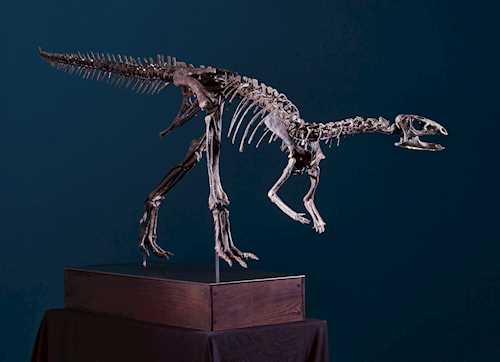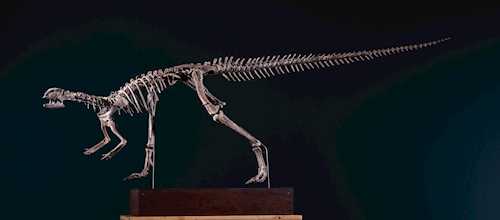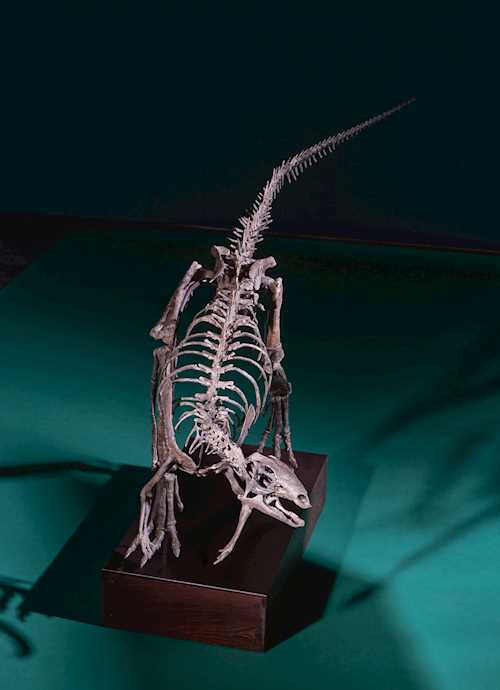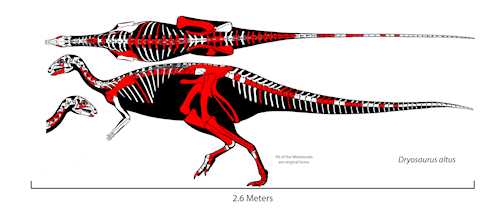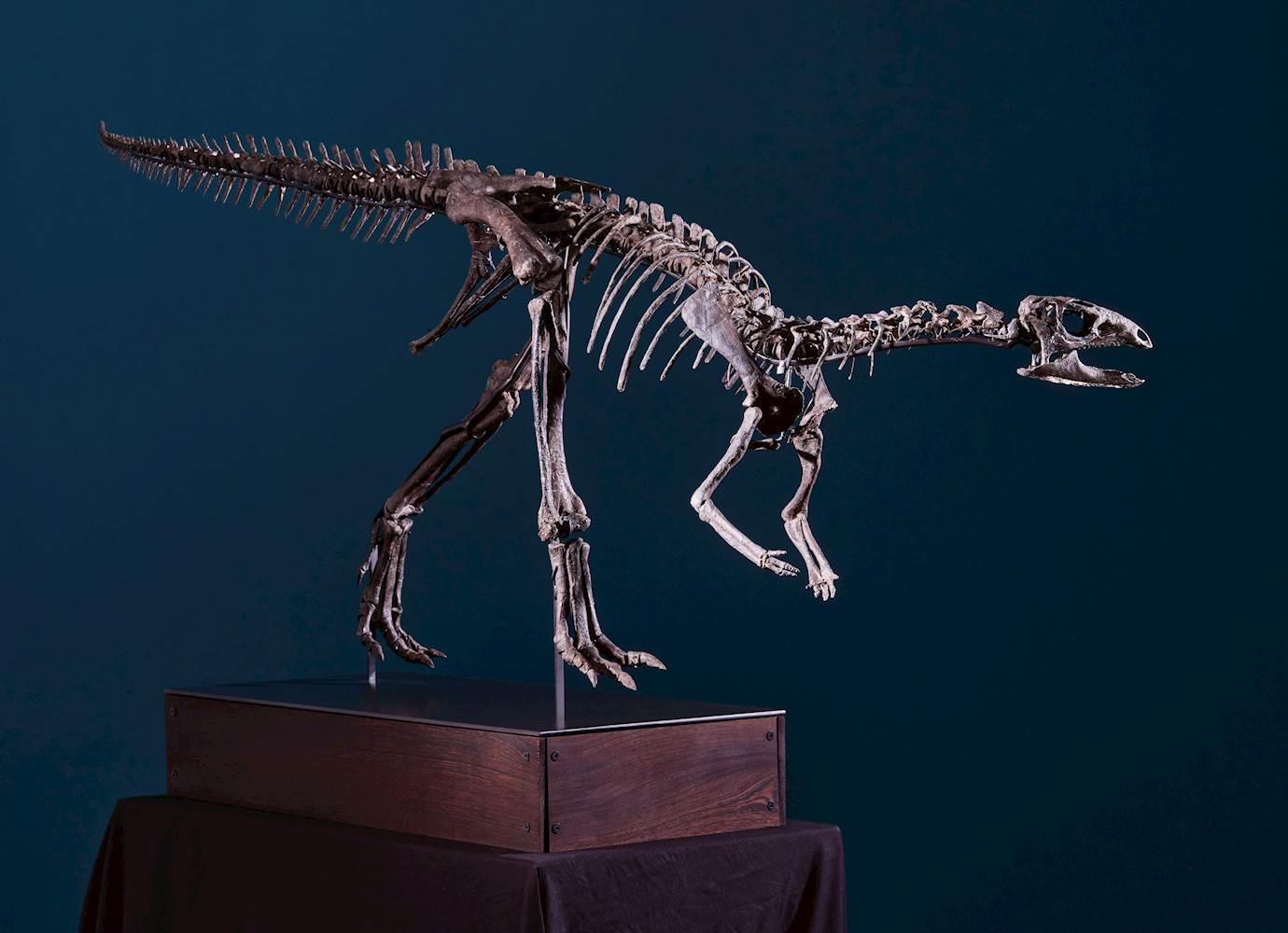
拍品 4032* - A209 Out of This World - Montag, 17. Juni 2024, 04.00 PM
‘ARTEMIS’, THE FOREST DWELLER
DRYOSAURUS ALTUS
Late Jurassic, 150 million years
Morrison Formation
Albany County, Wyoming, USA
Collected August 2021
65 – 70 % complete bone mass
260 × 66 × 91.5 cm (measurements not including stand)
On custom steel stand
‘Dinosaurs are not extinct; they live on in the hearts and minds of those who have studied them, who have dared to imagine what the world was like when they ruled’.
Steve Brusatte ‘The Rise and Fall of the Dinosaurs’
The Dryosaurus altus was a dinosaur that lived during the Late Jurassic period, around 150 million years ago. The name Dyrosaurus is derived from the Greek words for tree and lizard. This name reflects the forested habitat that this dinosaur is believed to have lived in.
It belongs to the genus of ornithopod dinosaurs that started out as small, running grazers and then grew in size and numbers until they became one of the most successful groups of herbivores in the Cretaceous world, 145 to 66 million years ago, dominating the North American land.
Physique of the Dryosaurus altus
Based on specimens such as the one examined here, Dryosaurus may have reached lengths of up to three metres and likely weighed approximately 100 kilograms. This dinosaur was characterized by a long neck, robust yet slender legs, and an elongated, rigid tail. The forelimbs were relatively short and featured five digits on each forefoot, lacking claws. It has been hypothesised that Dryosaurus possessed diminutive and colourful feathers, which would have contributed to thermal insulation.
Interestingly, the absence of anterior dentition suggests that Dryosaurus might have possessed a horny beak, which would not have been preserved in the fossil record. Nevertheless, the presence of molars clearly indicates herbivorous dietary habits, well-suited for consuming a variety of plant materials.
The primary defensive mechanism against predators for Dryosaurus was likely its agility. Observations of its hindlimbs, in which the lower segments were significantly longer than the femur, suggest a capacity for rapid locomotion. Some scholars estimate that it could have attained speeds of up to 40 kilometres per hour.
The place of discovery
This skeleton was discovered in August of 2021. It was found within the Morrison Formation, at Bone Cabin Quarry in Albany County, Wyoming. The peculiar name was given to this small location during the summer of 1897 when Walter Granger, a palaeontologist from the American Museum of Natural History, came upon a hillside littered with Jurassic-period dinosaur bone fragments. Nearby was a sheepherder cabin built entirely out of fossil bones, hence the name ‘Bone Cabin Quarry’.
The Morrison Formation consists of non-marine sediments that were deposited across a broad, comparatively flat land that was formerly covered by the middle to early Late Jurassic Sundance Seaway. 150 million years ago, when the Morrison Formation was deposited, the area was dominated by large rivers flowing from highlands in the south towards the north. A savannah type of environment of luscious ferns and conifers surrounded these rivers, providing an ideal habitat for a diverse variety of dinosaurs, including the Dryosaurus.
The Morrison Formation continues to be a valuable location for researchers and palaeontologists. It has provided critical information in understanding the evolution of dinosaurs. This locality has produced some of the most notable examples of dinosaur development.
Condition of the specimen and quality of restoration
The fossilised remains comprising this skeleton were discovered distributed within a confined area measuring approximately 3.5 × 3.5 meters. The dorsal vertebrae of the skeleton were found articulated, while other skeletal elements were located in close proximity. Based on these observations, it can be concluded with confidence that all the bones reconstructing this skeleton originated from a single specimen.
Each element has undergone meticulous preparation, and has been expertly mounted, preserving its intricate details. In this process, the latest, technologically advanced methods were used.
Since a representative part of each bone could be recovered during the excavations, it was possible to restore the skeleton with extreme accuracy. There is no evidence of 'pyrite disease' or other mineralogical complications that could jeopardize the future preservation of the fossil.
This complete skeleton of an adult Dryosaurus altus is of exceptional quality, displaying intricate details and robust outer surfaces. It exhibits a natural dark brown patina, characteristic of fossils from the iron-rich Morrison Formation. This specimen represents a remarkable artefact of Jurassic palaeontology and holds significant value for collectors and scholars alike.
Timeline of the discovery of Dryosaurus altus
1876
Samuel Wendell Williston discovers the remains of a small dinosaur in Albany County, Wyoming that would later be described by Othaniel Charles Marsh and named Dryosaurus altus.
1897
The American Museum of Natural History discovers a large dinosaur bone deposit in Albany County, Wyoming. From 1898 to 1903 the team from the museum works this site, discovering many dinosaur skeletons, including a partial skeleton of Dryosaurus altus. The site on which they make these incredible finds is called Bone Cabin Quarry.
1904
Henry Fairfield Osborn publishes an article in ‘Century Magazine’ entitled ‘Fossil Wonders of the West’. In the article, Osborn proclaims that Bone Cabin Quarry is the greatest find of extinct animals ever made. Osborne goes on to describe the discovery of the site and the many skeletons that were collected from it.
1988
Thomas Lindgren and Jeffrie Parker excavate a Stegosaurus dinosaur in Johnson County, Wyoming.
1990
Jeffrie Parker rediscovers the Bone Cabin Quarry site and begins exploring the dinosaur bone deposit. After more than a decade of working at the site, Parker and his crew have found more than twelve different dinosaur species.
1999
The book ‘Marsh’s Dinosaurs’ is reprinted with a historical update detailing Parker’s work and discoveries at Bone Cabin Quarry.
2021
Thomas Lindgren and Jeffrie Parker begin excavations at Bone Cabin.
2022
The present Dryosaurus altus skeleton is discovered by Thomas Lindgren and Jeffrie Parker, and subsequently prepared and mounted for exhibition.
'ARTEMIS' THE FOREST DWELLER
A 150-million-year-old sprinting herbivore
Christian Link and Yolanda Schicker-Siber present this astonishingly complete and beautiful skeleton of a Dryosaurus, and discuss what it may actually have looked like back in the Jurassic period.
CHF 380 000 / 600 000 | (€ 391 750 / 618 560)
以瑞士法郎銷售 CHF 219 700 (包含買家佣金)
所有信息随时可能更改。

